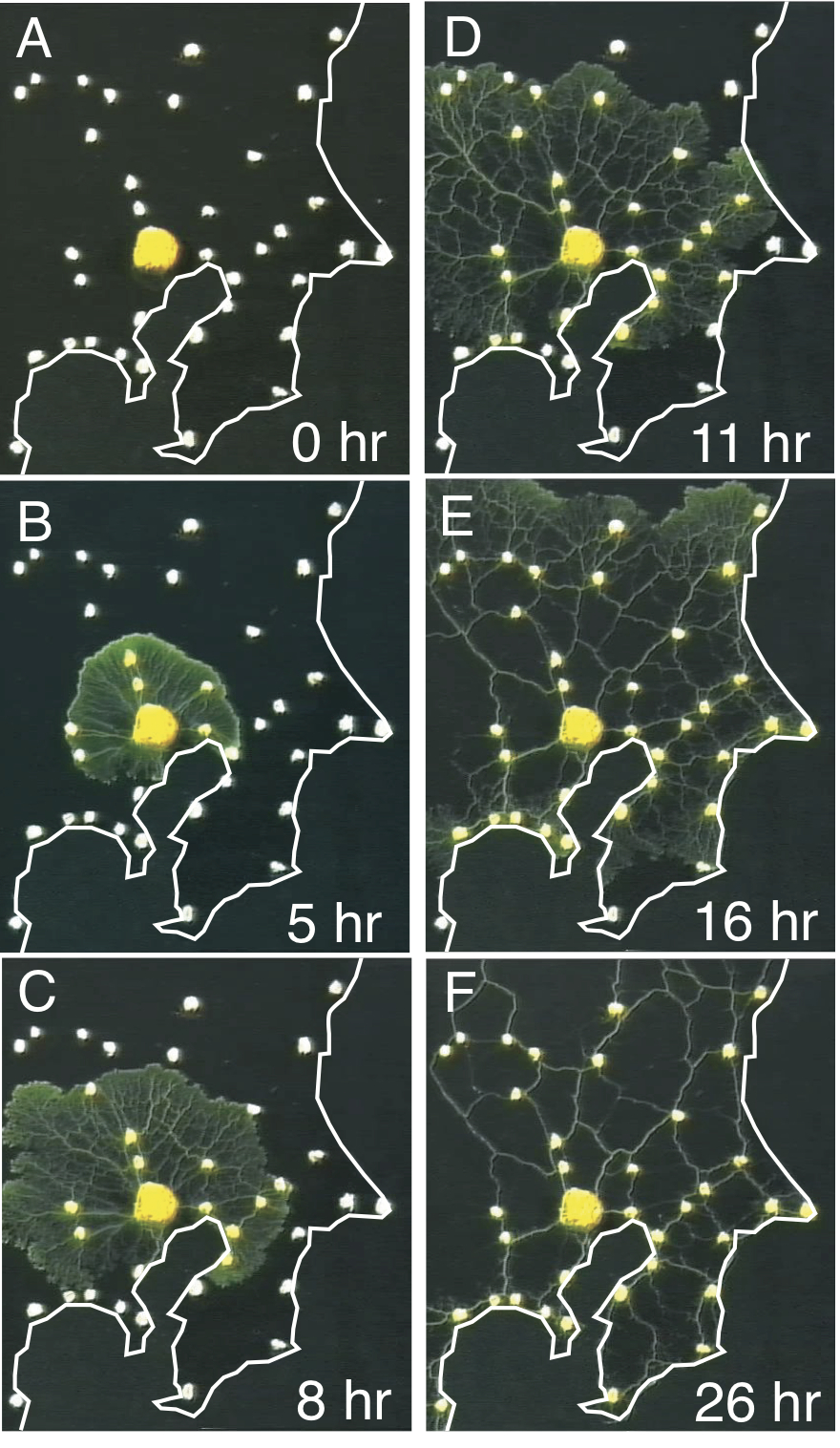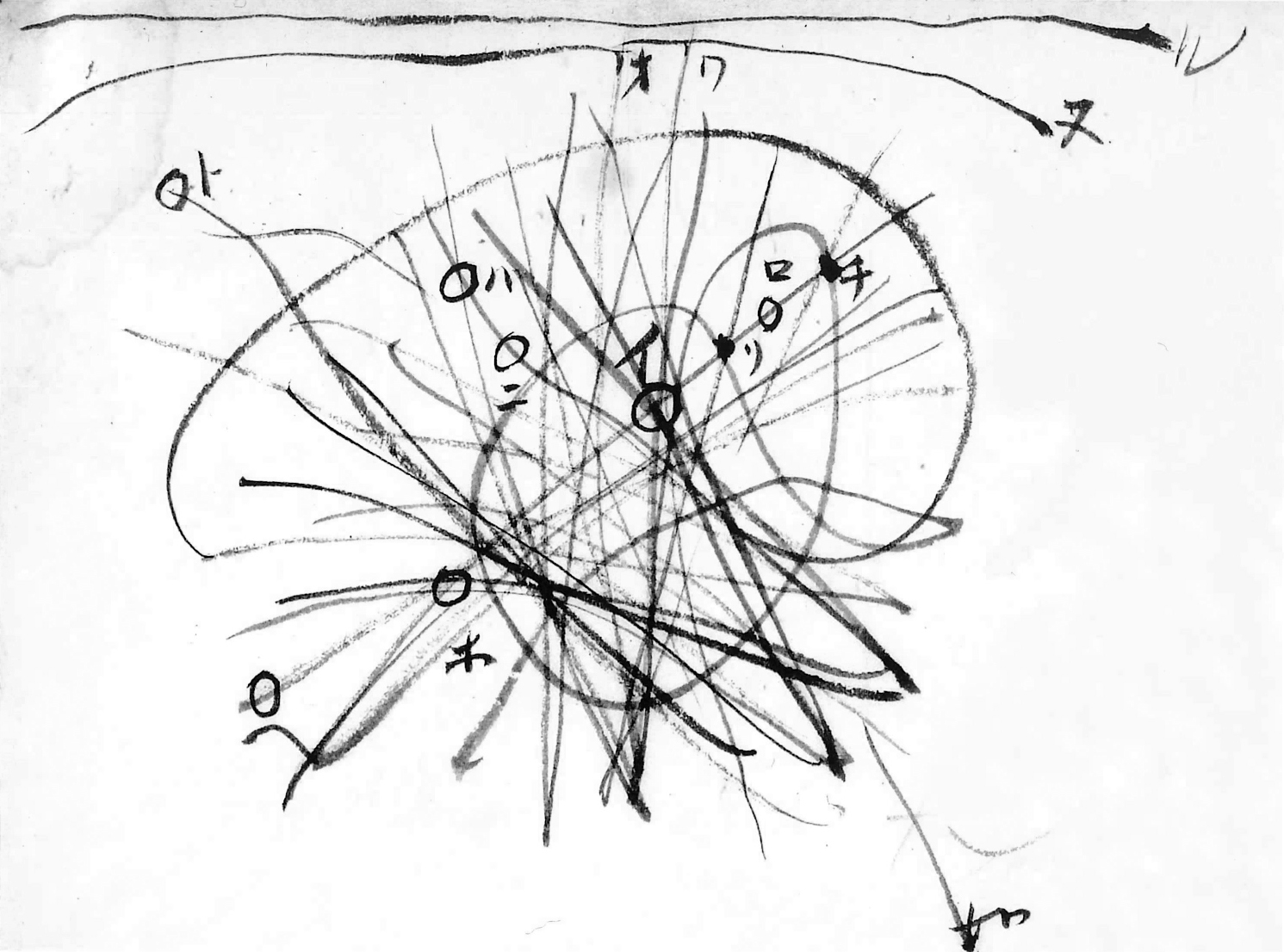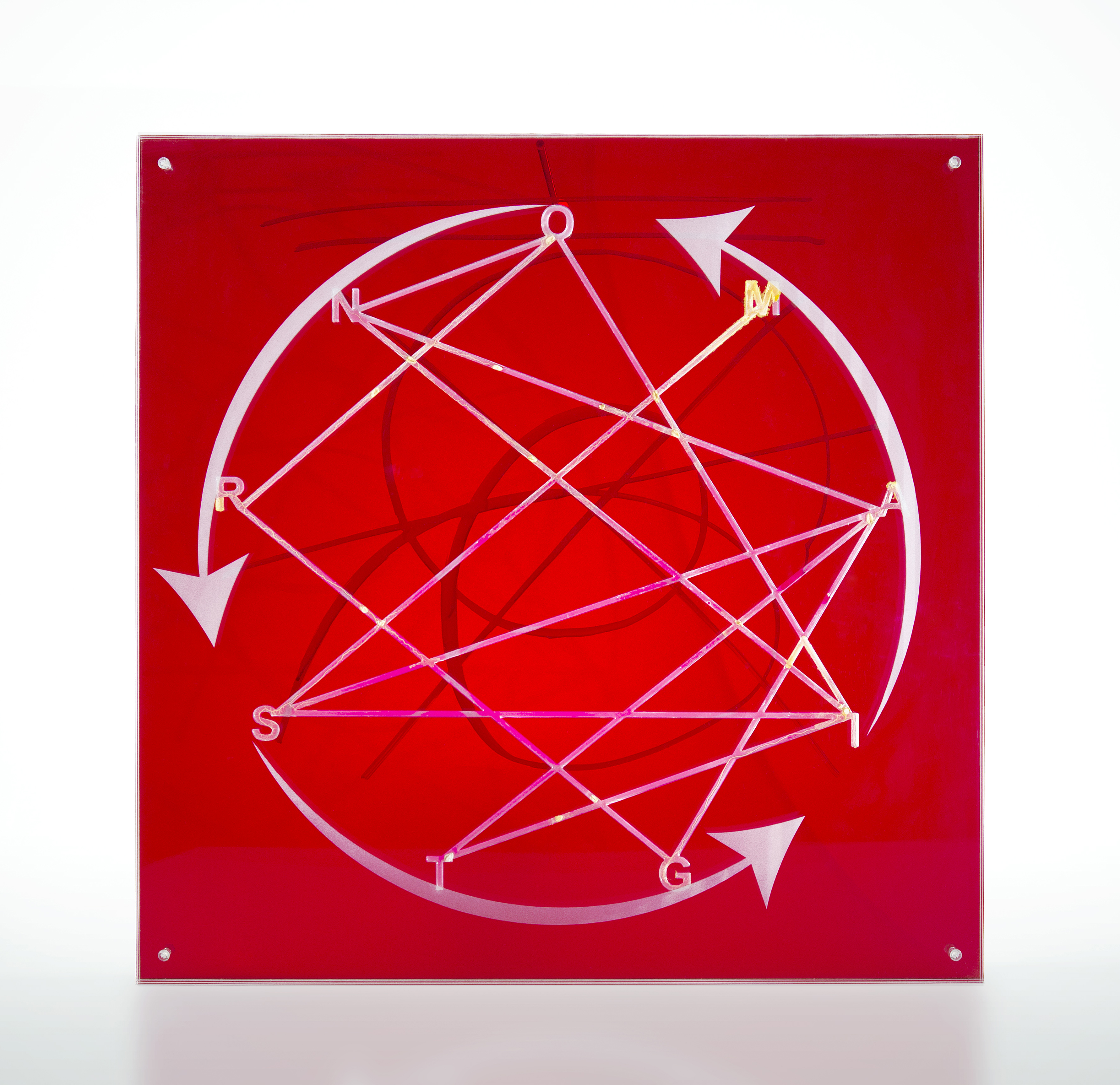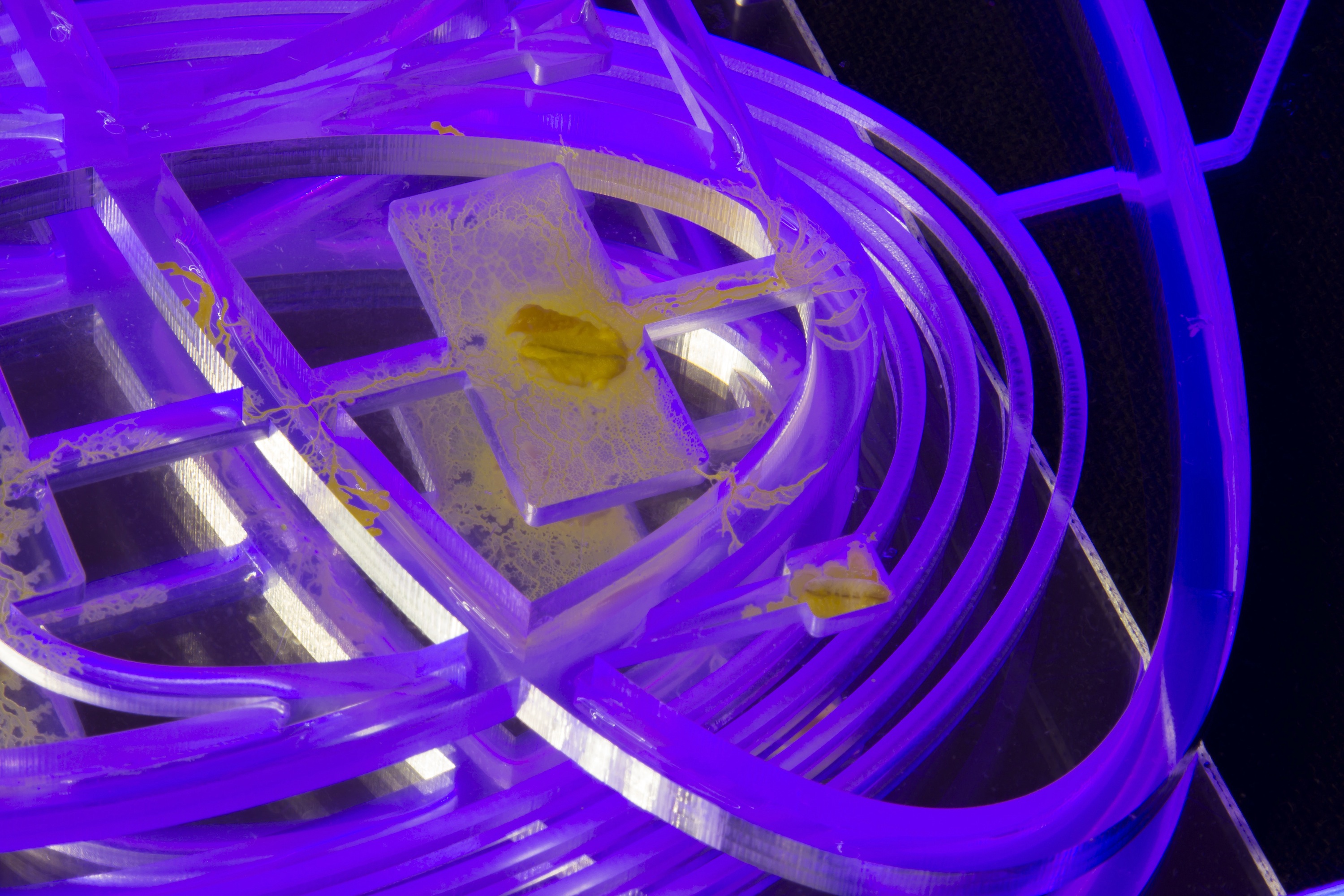Many Heads, No Brain
Physarum polycephalum is a single-celled organism invisible to the naked eye. However, in its ideal conditions—dark, wet, and bacterial—it multiplies into a visible bright yellow mass that spreads ostentatiously, fanning out in veins or erupting in polyp-like protrusions. The population of autonomous cells acts like a single being, moving and spreading with efficiency and coordination to find food and avoid light. Though it has no brain or nervous system, the group organism demonstrates advanced spatial intelligence.
Polycephalum, meaning “many-headed,” is a species of slime mold. Long assumed to be a type of fungus, slime molds are now considered Protists, “a taxonomic group reserved for ‘everything we don't really understand.’”1 Slime molds are ancient: they arrived hundreds of millions, perhaps a billion years ago, and theoretically, they’re immortal. If the slime can’t find resources it goes into hibernation, turning into a scab or growing spores to await future conditions when it can regenerate. In other words, it’s one of the earthly creatures best suited to survive planetary extinction. Lynn Margulis, the evolutionary biologist, argued that “those great evolutionary survivors, the lowly slime molds, would inherit the earth.”2
In the early 2000s a Japanese researcher named Toshiyuki Nakagaki placed a few cells of Physarum into a labyrinth with flakes of oatmeal at two ends. The slime quickly foraged the most efficient path between both food sources, finding the shortest route between two points—a job for which humans typically need equations or computational aids. Nakagaki then tried arranging the oats into an approximation of the geography of Tokyo and surrounding cities; the slime carefully extended itself across the oat-map into a shape remarkably similar to the existing railway network. In fact, unaffected by human bias and politics, Nakagaki says the slime actually may have improved upon the design of the railway system.
 Toshiyuki Nakagaki, Tokyo rail network experiment (2010). Image courtesy of Future University Hakodate and Seiji Takagi.
Toshiyuki Nakagaki, Tokyo rail network experiment (2010). Image courtesy of Future University Hakodate and Seiji Takagi.
In April 2016 the artist Jenna Sutela made a research trip to Japan to interview Nakagaki and other slime-scientists to document and learn from their work. Sutela is an artist whose practice has been following the trail of slime: the organism has become a collaborator/performer, growing inside recent sculptural works, while providing an ever-expanding rubric for material-based research into organizational intelligence and computation, both natural and unnatural. “The slime mold has served as a kind of a paranoiac-critical agent, helping me make connections where none previously existed. I trust its movement will take me where I need to go.”
Sutela does artistic research; I research artistic research. We overlap, we leave traces, we circle back on one another. We write this essay back and forth, to articulate each other’s thoughts: two heads working laterally through movement, tracing slimelike intelligence by simulating its collaboration. As Donna Haraway says: “To be a one at all you must be a many, and that’s not a metaphor.”3 What can we learn from a primordial organism about decentralized cooperation, material problem-solving, and the limits of consciousness? How does the slime mold know what it knows? How do we know what we know?
Beginning to Think
Understanding the behavior of polycephalum requires a reconsideration of the meaning of intelligence. Contemporary theories of intelligence almost universally rely on the “information processing” metaphor, that is, the idea that the intelligent brain processes data through computational actions like storage, transfer, and retrieval—though this is probably nothing like what brains really do. Computational intelligence as a metaphor for all intelligence is a historically specific construction, just like theories of mind throughout history, which tend to mirror the most advanced technologies of the time—at various times the brain has been described as a hydraulic system, an electrical circuit, and a set of chemical reactions.4 Many, including Noam Chomsky, have argued that no technological comparison will be accurate until we understand how consciousness works first; even if it could be artificially replicated, the process can’t be initially grasped through stabs at modeling it.5 So what if instead of looking for the most advanced metaphor to account for consciousness, we were to look to a “primitive” organic being like the slime mold, not only to understand or imagine how one brain works inside the skull, but also the way many brains work in concert?
Unlike a typical programmable agent that processes information through memory, slime mold decision-making can’t be predicted or replicated, since it coordinates itself entirely through sensory feedback with its environment. Exactly how this feedback happens is still unclear, but it has something to do with the extracellular slime traces that the cell leaves behind to tell itself where it’s already been. It does not make internal memories, but it does make choices based on past behavior. Its cognition is identical to movement; it knows exactly and only what it does. “Physarum’s spatial memory works,” writes Steven Shaviro, “not by internal representation, but rather by a physical marking of the very space that is being remembered. In this case, the map actually coincides with the territory.”6
Shaviro likens this behavior to the theory of Extended Mind, a philosophical concept put forth in the late 1990s that the brain and its environment can be seen as an indistinguishable coupled system. Nakagaki, on the other hand, compares it simply to the human unconscious response to stimuli.7 Both theories are metaphorical attempts to move beyond the information processing metaphor, by relocating intelligence altogether from the brain itself to a type of distributed, physically situated (site-specific) system.
If a seemingly simple organism can solve spatial problems through movement, artificial intelligence could conceivably do the same. Many scientists believe the future of robotics lies in such processes of decentralized movement, and the bodies of newly developed “soft robots” are designed to adapt and learn by moving through what are often called “genetic” or “evolutionary” algorithms. A research group led by Akio Ishiguro at Tohoku University, who Sutela visited, developed a soft-bodied amoeboid robot (its working title at one point was “Slimy”) inspired by the slime mold’s plasmodium. While traditional robotics focuses on controlling movement through motorized joints, soft robots adapt to their environments in real time, expressing ever-greater degrees of freedom than their rigid counterparts.
Organization, Organism, Orgasm
The slime mold is an organism but it is also an organization—not a train but a railway system. Like robotics, infrastructure design has begun to learn from the notion of decentralized, environmentally specific intelligence. Keller Easterling describes the evolution of massive worldwide infrastructure systems: “When the object of design is not an object form or master plan but a set of instructions for an interplay between variables, design acquires some of the power and currency of software. […] It is an ‘abstract machine’ generative of a ‘real that is yet to come.’”8 Sutela’s artworks involving Physarum become such abstract machines generating alternate realities. However, the design is not only a set of immaterial “instructions”—in this case better thought of as suggestions or provocations—but also the materials through which those instructions are enacted (or not). That the slime mold is incorporated into the work outsources some of the decision-making process to spatial, non-human intelligence, which is interpretable only through its movement. The abstract machine becomes a soft machine.
Working with a living organism as an artistic material requires adapting along with it: besides the act of keeping it alive, there’s the fact that not every museum or gallery wants mold-eating spores spreading around the exhibition, and so the life-form must stay contained in its artwork. Building a host sculpture therefore becomes an infrastructural design challenge, a calibration of multiple parts to form a whole. “Creating the works is like creating a laboratory. The slime needs a habitat—not just an installation, but an architectural space.” The habitats she builds are interactive, often resembling mazes. The labyrinth as a generative form contains not only the formal history of computational problem solving and theories of mind, but also represents the collision of the natural and artificially constructed space.9
Sutela’s works are grouped into an ongoing project called Orgs, which stands for Organization, Organism, and Orgasm. A circular motif recurs throughout the works: a feedback loop, a zero, an open mouth, a Petri dish. A living slime mold draws itself across a maze of three-dimensional Plexiglas forms derived from organizational charts and networking diagrams, the surfaces of which are coated with agar for moisture and dotted with oats for nutrition. In the most recent iteration, a series of three hanging, transparent, hand-sized spheres called Orbs (2016) were shown in an exhibition at Future Gallery in Berlin, the micro-climates also containing sticks of activated charcoal to purify the air within each orb. Housed in the dark gallery basement, the orbs are illuminated by infrared light; while Physarum is unique for a Protist in that its activity is visible to the naked eye, it paradoxically does not like to be seen, adding to the logistical and theoretical puzzle of putting it on display.


The third sphere contains a “Holacratic” organizational chart. The term originates in an essay from 2007, in which the American software engineer Brian Robertson used the word “Holacracy” to describe a system of corporate self-organization by which a company is organized into overlapping “circles,” teams of employees who come together spontaneously around specific tasks.10 Contemporary management theory has generally come to treat social groups as organisms possessing their own form of intelligence. Circles and holons replace linear organizational charts; role definitions become fluid, relationships become transient. Holacracies may retain hierarchical forms, but they are “value-neutral” hierarchies.
As a living model of non-linear action and lateral collaboration, the slime mold prompts the question of whether organizations could ever truly develop “naturally” as an organism, devoid of top-down controls, or whether imposed horizontality only advances the interests of external forces governing the body, instead of the interests of its constituent parts. The idea of a “conscious” organization is as disturbing as it is compelling. A decentralized, autonomous organism has no ideology, ethics, or accountability, whereas it might be preferable for a corporation to act according to a core logic beyond self-serving opportunism. In the case of Holacratic systems of corporate organization, it’s hard to imagine the “oatmeal” driving the participants as being anything other than capital. Mike Pepi describes the trouble with decentralized organizations in terms of “asynchrony,” or non-linearity:
We have dreamed about the revolutionary potential of self-organization for generations, but the apparent harmony between asynchrony and anarcho-syndicalism, libertarianism, or horizontalism obscures the extent to which an engineer’s fantasy has become management’s best friend. The decentralization achieved by asynchrony is different from the political ideal of decentralization. From the perspective of the individual worker, asynchrony doesn’t remove authority as much as displace it. 11
For humans to act as a decentralized system constantly oscillating between competition and collaboration to the point where the two can no longer be distinguished, moving in the most efficient ways according to self-serving opportunities—that’s already the condition of the free market.12 And yet, it’s also the condition of resistant, resilient, “polycephalous” political movements, those adaptable, semi-coordinated networks of individual cells who join together and multiply, only becoming visible when they arise en masse. The remarkable intelligence of polycephalum is not in its asynchronicity, but in its lack of any need for a manager governing that decentralized movement.
Becoming Other
For a performance at the Centre Pompidou in spring 2016, Sutela inhaled some “script-defining spores” of polycephalum before a performative reading. Near her was a physical work, a sandwich of Plexiglas plates. The bottom plate was colored red to distort the light to the slime mold’s preferred color, and had an interpretation of the Minakata Mandala drawn over it; the middle one had a “word maze” with agar, oats, and replicating cells of polycephalum, and the protective top layer had a circle of arrows creating a shadow on the slime, potentially affecting is movement as it has an affinity for darkness.

The word maze consisted of lines leading in a starlike pattern to the letters of the words “organization,” “organism,” and “orgasm.” In her reading she gave clues to the connections between these words, at one point explaining: “Orgasms may induce a brief loss or weakening of consciousness, la petite mort. According to Professor Nakagaki, by focusing on the level of unconsciousness, we may find clues to the similarities between the information processing of humans and other forms of organic and synthetic life. […] Artificial intelligence has been trapped on the level of consciousness for too long.” Imagining that the behavior of the polycephalum she’d ingested before the performance was “programming” her own, her speech act became itself a form of artificial intelligence. The reading was co-designed, moving towards the unconscious.
Nakagaki once felt an irresistible urge to eat the organism he devoted his life to studying.13 From his description, it’s hard to identify a scientific goal in doing so; he’d veered into the territory of non-empirical experimentation at that point. There is, from the other side, a long history of artistic fascination with biological organisms that overlaps with scientific methodology, but that often winds up in the same not-quite-empirical territory too. John Cage, for one, became biologically inclined via his adoration for all types of mushrooms. His mycological obsession likewise led him to eat them (including poisonous ones) as if driven by a desire for understanding through symbiosis, a non-codified type of knowledge. Like the slime mold, mushrooms were particularly interesting to him because they are so difficult to taxonomize—in reading his accounts, it seems as if only by achieving physical oneness with the organism did he feel he could begin to understand the mysteries of mushroom intelligence.
However, while Cage sought chance encounters without making conclusions, claiming that artists should ask questions rather than seek to provide answers (referring to a type of artistic “divination”), Sutela’s interest in slime mold’s intelligence is an interest in answers—there is a real element of experimentation in each of the physical works she creates. Will the slime mold react to the conditions of light and darkness she sets up each time? Will its presence affect her performance? What word(s) will it spell out as it grows across the maze? How does it communicate with the viewer? The behavior of her companion species enacts a type of knowledge beyond codified systems of representation. And likewise the artwork becomes a living, unpredictable, unknowable entity.
Art constructs systems of knowledge and belief that can be as rigid as any other, and often does this by (over-)explaining what it knows. Sutela’s Orgs suggest the potential for other kinds of knowing that cannot necessarily be transmitted through existing channels of artistic or scientific research. She invents a new type of movement, a new language of forms—“form as action” as opposed to “form as object.”14 Artwork whose form is action is self-learning artwork—software rather than hardware. This could also be described as the distinction between “knowing that” and “knowing how.”15 To know that the slime mold moves in a certain way because of certain capabilities—that’s scientific research. To know how through the act of moving along with it—that’s the work of the artist.
-
1 Ferris Jabr, “How Brainless Slime Molds Redefine Intelligence,” Scientific American, November 2012. http://www.scientificamerican.com/article/brainless-slime-molds/?print=true
2 Steven Rose, “Lynn Margulis Obituary,” the Guardian, December 2011. https://www.theguardian.com/science/2011/dec/11/lynn-margulis-obituary
3 Donna Haraway, Anthropocene, Capitalocene, Cthulucene, Lecture, University of California Santa Cruz, 2014. https://vimeo.com/97663518
4 Robert Epstein, “The Empty Brain,” Aeon, May 2016. https://aeon.co/essays/your-brain-does-not-process-information-and-it-is-not-a-computer
5 Noam Chomsky Lecture on Artificial Intelligence, Lecture at Navigating a Multispecies World: A Graduate Conference on the Species Turn (Cambridge, Massachusetts: Harvard University, 2013), https://www.youtube.com/watch?v=TAP0xk-c4mk.
6 Steven Shaviro, Discognition (Repeater, 2016).
7 Interview with Jenna Sutela, April 5, 2016.
8 Keller Easterling, Extrastatecraft (Verso, 2014).
9 “The questions of life and its control are central to the labyrinth and the garden. The growing and the made: just as nature is ordered in the garden, so subjects are "produced" in the labyrinth.” Olaf Nicolai, Jan Wenzel and Sadie Plant, Labyrinth (Spector Books 2012 / Rollo Press 2013).
10 Brian Robertson, Organization at the Leading Edge: Introducing Holacracy™ Evolving Organization, Integral Leadership Review, 2007, http://integralleadershipreview.com/5328-feature-article-organization-at-the-leading-edge-introducing-holacracy-evolving-organization/. Robertson borrowed the term from Arthur Koestler’s 1967 philosophy/psychology book The Ghost in the Machine, in which Koestler invents the word “holon” to describe oneness of mind and body. Koestler argues that the brain is made up of holons that are autonomous and self-determining yet also fundamentally dependent on the brain as a whole.
11 Mike Pepi, “Asynchronous! On the Sublime Administration of the Everyday,” e-flux journal #74, June 2016.
12 An economist named Alan Kirman made this connection in 2015: “Economies are like slime molds, collections of single-celled organisms that move as a single body, constantly reorganizing themselves to slide in directions that are neither understood nor necessarily desired by their component parts.” From the Ernst Strüngmann Forum Complexity and Evolution: A New Synthesis for Economics, February 1–6, 2015.
13 “One time I tried to eat a very small portion of a slime mold. It tasted like nothing. After half an hour, I felt some irritable feeling on the tongue. Something happened. I tried to remove it, gargling. One hour later, I felt nothing.” Interview with Jenna Sutela, April 5, 2016.
14 Easterling, 81.
15 Gilbert Ryle makes this distinction in The Concept of Mind (University of Chicago Press, 1949).
-
Top image: Jenna Sutela, Orgs (2015). Physarum polycephalum, agar, and oats inside a Holacratic organizational chart; fragment of a larger Plexiglas container. Photo by Mikko Gaestel.


